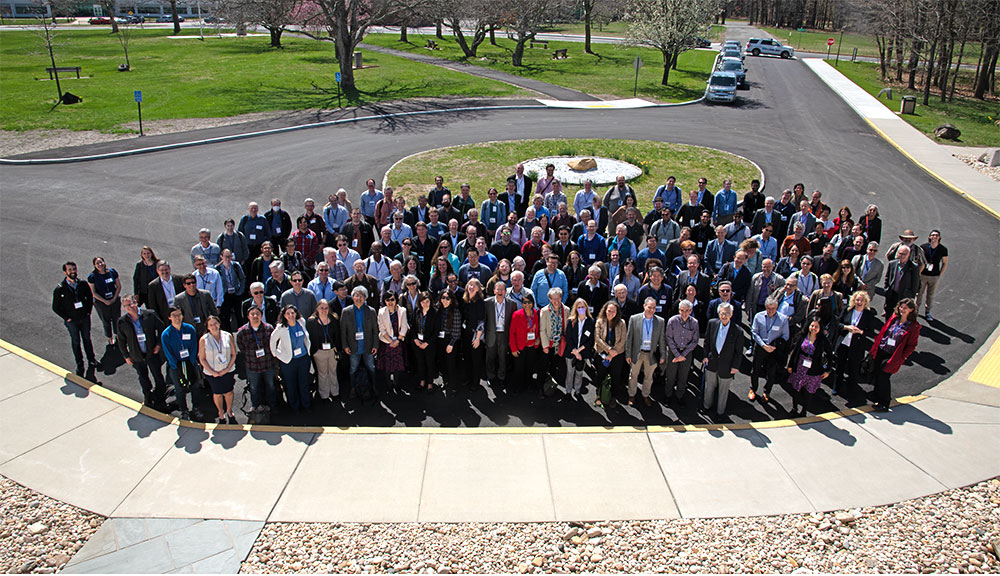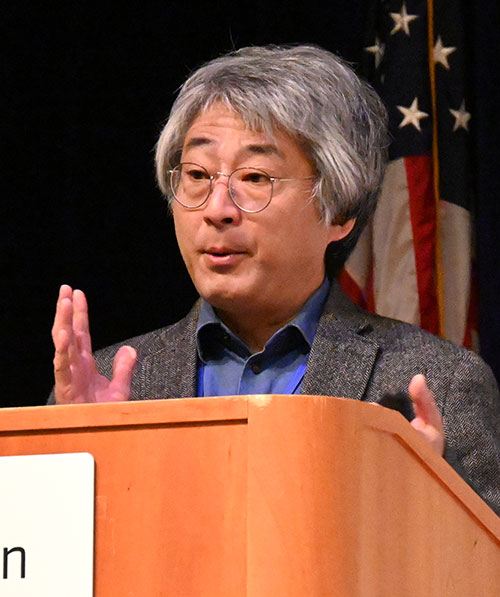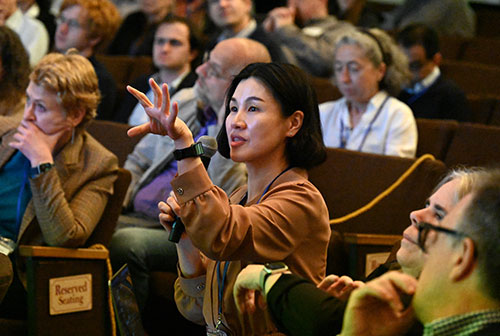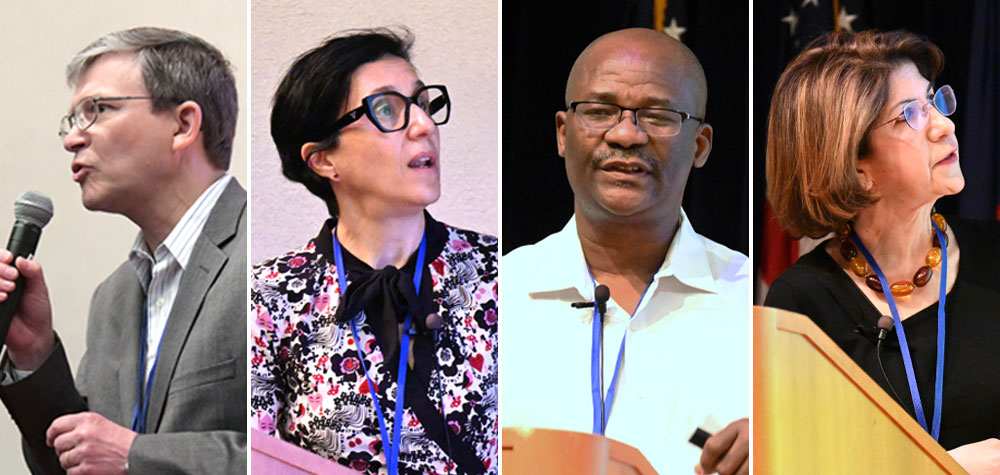P5 Town Hall Held at Brookhaven Lab
The third of four meetings in 2023 explored energy, instrumentation, and computing in the next decade of particle physics
June 9, 2023
 enlarge
enlarge
Hundreds of members of the U.S. particle physics community gathered at Brookhaven Lab this April for the third of four Particle Physics Project Prioritization Panel (P5) Town Hall meetings of 2023.
Hundreds of members of the U.S. particle physics community gathered at the U.S. Department of Energy’s (DOE) Brookhaven National Laboratory this April for the third of four Particle Physics Project Prioritization Panel (P5) Town Hall meetings of 2023.
Building on the Snowmass study, the P5 Town Hall offers a space for experts in particle physics to present various proposals for the field, which the P5 Panel will then prioritize for the next decade. Each of the four meetings that comprise the Town Hall includes a set of invited talks on broad science questions and goals, as well as discussions on planned facilities and experiments and their costs and schedules. P5 will report the information gathered during the Town Hall to the High-Energy Physics Advisory Panel (HEPAP), which advises the DOE Office of Science and the National Science Foundation (NSF) Division of Physics on how to allocate future funding.
The Town Hall meeting at Brookhaven focused on the energy, instrumentation, and computational frontiers. Previous Town Hall meetings at DOE’s Berkeley Lab and Fermilab focused on the cosmic frontier and the neutrino, rare processes, and precision frontier, respectively. The fourth and final Town Hall meeting, held at DOE’s SLAC National Laboratory in May, focused on the underground, accelerator, and theory frontiers, as well as community engagement.
 enlarge
enlarge
P5 chair Hitoshi Murayama gave an introduction to the Town Hall, covering the key elements for making P5 successful: being well-informed by the science community, setting a long-range vision for the field, offering a balanced portfolio of experiments of all sizes and scope, and engaging the community.
The Brookhaven meeting kicked off on April 12 with an introduction to the Lab by then-Director Doon Gibbs. After announcing in 2022 his plans to retire, Gibbs stepped down from the Lab on April 17. Theoretical physicist JoAnne Hewett was named as the Lab’s next director and is set to join the Lab this summer. Hewett attended the P5 Town Hall meeting at Brookhaven and, at that time, served as Chair of HEPAP.
“It is a great pleasure for me to welcome all of you to Brookhaven Lab for the third P5 meeting. The challenges we face will require diverse perspectives and technical expertise,” Gibbs said, noting the complexity of the particle physics field and the importance of giving a platform to the many voices of the community. Gibbs also discussed the science areas of focus at Brookhaven and the Lab’s user facilities, with a special focus on the upcoming Electron-Ion Collider.
P5 chair Hitoshi Murayama gave an introduction to the Town Hall, covering the key elements for making P5 successful: being well-informed by the science community, setting a long-range vision for the field, offering a balanced portfolio of experiments of all sizes and scope, and engaging the community. He then discussed the changing landscape of particle physics and takeaways from Snowmass.
Science talks began with the energy frontier, with Florida State University Professor Laura Reina introducing the frontier as an exploration of the TeV (tera electron volt) scale and beyond. She presented the “big questions” as the evolution of the early universe, matter/antimatter asymmetry, the nature of dark matter, the origin of the neutrino’s mass, the origin of the electro-weak scale, and the origin of flavor. She then discussed the tools we have to answer these questions, mainly by looking for direct and indirect evidence of physics beyond the Standard Model.
The Higgs Boson was central to Reina’s talk, as well as many others in the energy frontier. Subsequent talks in the energy frontier covered the science program and detector development for the high-luminosity Large Hadron Collider and many other new and proposed facilities and experiments, including an electron-positron collider as the Higgs factory and a longer-term, higher energy muon collider.
 enlarge
enlarge
Everyone from postdocs to senior scientists participated in the meeting, showcasing the community's engagement at every level.
The instrumentation frontier was introduced by Jinlong Zhang, a physicist at DOE’s Argonne National Laboratory, who discussed detector technologies and R&D needs for future experiments in collider physics, neutrino physics, intensity physics, and research at the cosmic frontier. He highlighted the importance of collaboration between researchers, facility stewards, students, and members of industry.
The roles of each of those groups was discussed in detail during additional talks, including a session on workforce development by Gabriella Carini, director of Brookhaven Lab’s Instrumentation Division. She discussed creating a workforce “pipeline” facilitated by internships and hands-on training through educational programs, such as those provided at Brookhaven Lab through DOE.
The computing frontier was introduced by Daniel Elvira, a scientist at Fermilab. He covered emerging technologies like artificial intelligence and quantum computing, how those technologies have changed since the last P5 Town Hall, and recommendations for implementing those technologies in the future. Additional talks in this frontier dove deeper into using these technologies as tools for discovery.
Jim Misewich, Associate Lab Director for Energy and Photon Sciences at Brookhaven Lab, gave a presentation on the Co-Design Center for Quantum Advantage (C2QA). C2QA is one of five National Quantum Information Science Research Centers funded by DOE and is led by Brookhaven Lab with support from several partners across academia and industry. The center aims to achieve “quantum advantage,” the point at which a quantum computer outperforms a classical one, through the co-design of hardware, software, and materials. Misewich discussed the synergy between C2QA’s mission and P5’s goals in the computing frontier.
Another notable talk came from Brookhaven Lab physicist Ketevi Assamagan. Assamagan discussed the importance of diversity, equity, and inclusion in the physics community—in particular, why the United States should support physics education internationally in Africa and beyond. Not only would such support improve international engagement in areas of national interests, Assamagan argued, but it would also improve quality of life around the world and benefit all humankind. He noted that individual institutions have been putting forth effort, but a cohesive approach from the larger high-energy and particle physics community is needed.
 enlarge
enlarge
A selection of the meeting's speakers, pictured from left to right: Dmitri Denisov, Gabriella Carini, Ketevi Assamagan, and Fabiola Gianotti.
Day two of the Town Hall introduced perspectives from the directors of international particle physics facilities, with Masa Yamauchi covering the physics program at KEK in Japan, Yifang Wang covering IHEP in China, and Fabiola Gianotti covering CERN in Europe. Then, a wide series of talks discussed ideas for future colliders, including circular and linear colliders, muon colliders, and more.
To end the main science talks of the Town Hall, Dmitri Denisov, Deputy Associate Laboratory Director for High Energy Physics at Brookhaven, presented the Lab’s work in high energy and particle physics. He discussed how the Brookhaven program reaches all of P5’s frontiers and works in synergy with many other Lab organizations. Brookhaven Lab provides major contributions to particle physics experiments around the world, including the ATLAS experiment at CERN, short and long baseline neutrino experiments at Fermilab, the Belle II experiment at KEK, and the Rubin Observatory. The Lab also offers robust work in high energy theory and R&D for detectors and accelerators.
“Brookhaven Lab is well positioned to lead and participate in future particle physics facilities and projects, thanks to our deep expertise in all aspects of particle physics and technologies involved, as well as our long-term productive cooperation with other laboratories and universities, both nationally and internationally,” Denisov said.
The Town Hall meeting concluded with two and half hours of allotted time for invited short remarks and an open mic session, giving the entire community the opportunity to express their ideas, findings, and opinions. Everyone from postdocs to senior scientists participated, showcasing the community’s engagement at every level.
The high level of engagement and participation in the meeting would not have been possible without the contributions of the Lab’s Information Technology Division, the Laboratory Protection Division, and all other support organizations whose efforts made the largest post-pandemic meeting at the Laboratory a success.
Moving forward, P5 will hold additional virtual meetings to receive further input from the community.
Brookhaven National Laboratory is supported by the Office of Science of the U.S. Department of Energy. The Office of Science is the single largest supporter of basic research in the physical sciences in the United States and is working to address some of the most pressing challenges of our time. For more information, please visit science.energy.gov.
Follow @BrookhavenLab on Twitter or find us on Facebook.
2023-21182 | INT/EXT | Newsroom









